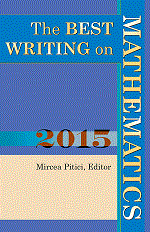The Best Writing on Mathematics 2015by Mircea Pitici (ed) |

|
This is the sixth book in "The Best Writing on Mathematics" anthological series. This will be the first time that I shall offer any critique on the essay selection.
The book starts with a humorous panegyric to the blackboard which is convincingly shown to be an indispensable implement of mathematical research, notwithstanding the drawbacks of using the chalk. The whimsical character of the first chapter creates the mood for a smooth transition to the second one that starts with a multiple choice puzzle:
Multiply together the number of fingers on each hand of all the human beings in the world - approximately 7 billion in all. Is the answer approximately: A) $5^{7,000,000,000}\;$ B) $10^{7,000,000,000}\;$ C) $5^{14,000,000,000}\;$ D) Something else entirely?
The answer is $0\;$ (D) suggested by the hint "Some people may be missing some fingers," which is supposed to elicit a small "Aha!" moment. The "Aha!" moments that embrace the conjunction of cognition and emotion are qualitatively unique to humans among all other intelligent animals.
What is different about human beings is our underlying emotional attitude to problem solving. We seek out puzzles and learning for fun.
Thus the uplifting, cheerful second chapter, "How Puzzles Made Us Human," serves as a natural introduction to the volume in which, according to the editor, "... a greater number of contributions than in the previous volumes concern mathematical games and puzzles." The reader may join me in wondering what these chapters have to do with writing on mathematics, let alone mathematics proper. However, the truth is I enjoyed reading the first chapter and discerned a meaning in including the second one; I would have overlooked their inclusion and proceeded to the otherwise great selections, if it were not for a couple of chapters on mathematical education. Neither can be possibly judged as a writing on mathematics. But worse, I found one of the chapters, "The Future of High School Mathematics," misleading. As the authors mentioned,
Mathematics educators who have been active in reform efforts for the past two decades will probably point out that our ideas for the future of high school mathematics have been expressed in earlier policy documents and curriculum projects inspired by the NCTM Standards. But it seems safe to say t hat we have a long way to go before those recommendations are common practice in most U.S. high schools. The force of tradition in education makes its aims and practices consistently and powerfully resistant to change.
I just gasped at the title of the subsection "What Should Students, Teachers, Parents, and Policy Makers Look For in the Emerging Reform of High School Mathematics?" What? The reform is still emerging? What about the last 20, 30, 40, nay 50 years? I could have said more about that chapter and the educational reform in general but this review is not a place for such a discussion. I simply regret that I happened to read that article, and the same holds for the next chapter, "Demystifying the Math Myth: Analyzing the Contributing Factors for the Achievement Gap between Chinese and U.S. Students." At this time and day, it is simply impossible to read about differences in culture, students' and parents' attitude toward education, teacher qualifications and preparedness, as a revelation.
As to the rest of the book, I enjoyed some chapters more than the others - which was to be expected - but I found what I read informative, well written, and quite entertaining. The reader can find the Table of Contents at the amazon.com site. I shall mention a few chapters that I enjoyed most.
"Chaos on the Billiard Table" delivers a perfect illustration of the mathematical research paradigm. Starting with a model of the common billiard, mathematicians have removed the pockets for the ball to drop in and made the balls weightless; they kept the reflection laws but instead of reflecting the balls, they reflected the table; they added obstacles to deflect the balls and placed them on tables of various shapes (like ellipse) and surfaces (like sphere and torus, and kept adding the holes); they found links to the theory of gaseous subtances and high sensitivity to the initial impulse. Among the many illustrations, an attentive reader may even notice an instance of the Poncelet porism. A beautiful theory and an enlightening exposition.
In "The Quest for Randomness" we learn of the history of attempts to define the notion of randomness - statistically, via the complexity theory, with finite automata and quantum mechanics. Much of it is associated with the games as Conway's Game of Life and a stranger one played by two people on different planets based on the synchronized behavior of entangled particles. There is also Conway and Kochen's "Free Will" Theorem. The notion of randomness is not easy and to a great extent counterintuitive. Mathematicians have finally managed to produce random numbers, but only a bit at a time, that confirm to the concept of "Einstein-certified randomness."
The histories of the Game of Nim and the Pigeonhole Principle are surprising, edifying and entertaining; the odyssey of Goodstein's theorem and its creator is fascinating; an explanation of perspective in Dürer's paintings is instructive and enriching. But there are 30 chapters to choose from that will satisfy and match the multitude of tastes of math professionals, teachers and buffs.
The Best Writing on Mathematics 2015, by Mircea Pitici (ed). Princeton University Press, 2016. Softcover, 392 pp, $24.95. ISBN 978-0691169651.
|Up| |Contact| |Front page| |Contents|
Copyright © 1996-2018 Alexander Bogomolny73496902
